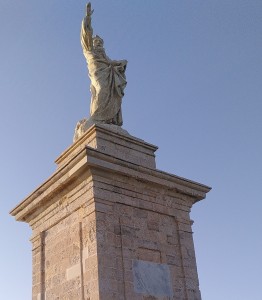St Paul’s Island – St Paul stranded on his way to Rome
St Paul’s Island or Selmunett is an uninhabited island of about 10 hectares off Selmun, Mellieha. According to the Bible, a sailing ship with the Apostle Paul on board ran aground on its way to Rome. St Paul converted the Maltese to Christianity. They named the island off the coast St. Paul’s Island in his honour. There is a statue of St Paul on the island, which rises around 21 metres out of the water.
Where is Saint Paul’s Island located?
St Paul’s Island is located in the north near Mellieħa. The two uninhabited island rocks of St. Paul’s Island (Il-Gżejjer ta’ San Pawl in Maltese) rise up to 21 metres out of the water. The connection between the two rocks is only a few metres wide. It is washed over by strong waves. Saint Paul’s Island is located at the western end of St Paul’s Bay. Officially, the area of St Paul’s Island is 0.101 km². The statue of St Paul stands at the highest point of the island. His gaze is directed towards Bugibba. Mellieha is up to 160 metres above sea level. From Mellieha you can only see St Paul’s Island from Selmun Beach and from the north from Mellieha Bay. From St. Paul’s Island you have a magnificent view of the Mediterranean to the east and south, as well as the town of St. Paul’s with Bugibba and Mistra Bay just a few hundred metres away.
How to reach St Paul’s Island?
The Selmun beach in Mellieha is only 90 metres away. You can reach the island by swimming or with a SUP and kayak. Otherwise, many boat tours visit St Paul’s Island. A paved path leads about 200 metres from the island’s jetty to St. Paul’s statue.
How was the St Paul’s statue created?
The large statue of St Paul the Apostle on St Paul’s Island is the work of two sculptors, Sigismondo Dimech (1780-1853) from Valletta and Salvatore Dimech (1805-1887) from Lija. The statue is about 4 metres high. St Paul holds a book in his left hand, while his right hand points to the sky. At his feet is the serpent which, according to the Acts of the Apostles, bit him on the hand. The statue stands on an 8.3 metre high platform by the stone carver Francesco Spiteri. The inscription on the attached marble slab reads:
To the Apostle St Paul, Master and Doctor of the Church of all People, Father and Patron of the Maltese. This statue is in the same place where he was shipwrecked – together with 275 others – on this island where he had to come and teach the faith of Christ, as his friend St Luke says in the Acts of the Apostles Cap.XXVII. Salvatore Borg, in memory of this event – in the year 1845 – worked hard for its erection.
St Paul converted the Maltese to Christianity
Apostle Paul lived on Malta for three months with 275 fellow travellers. He converted the Maltese to Christianity. For the Maltese, St Paul is one of them. He is one of Malta’s most important saints. One of the miracles surrounding St Paul is that he survived a bite from a poisonous snake. Many statues and pictures of St Paul depict the event. The rocks of the shipwreck were named in honour of the apostle. He travelled from Malta to Rome via Syracuse, Rhegium and Puteoli. On 10 February, Malta celebrates the Feast of St Paul’s Shipwreck (San Pawl Nawfragu and Feast of St Paul’s Shipwreck).
Perhaps the most famous biblical quotation from the Apostle Paul:
If anyone does not want to work, neither should he eat’ (2 Thess 3:10)
That sounds like a sentence from the party programme of the Christian parties CDU / CSU or the marketing of the Confederation of German Employers’ Associations. However, this verse is said to come from St Paul. Or did the Apostle Paul call for an ‘unconditional basic income’ 2000 years ago? The phrase is being politically misused by the Christian parties by taking it out of context. Paul wrote this sentence in his second letter to the church in Thessalonica. The following sentences follow:
2 Thess 2,11 For we hear that some of you walk disorderly and do nothing, but do vain things.
2 Thess 2,12 But to such we command and exhort in the Lord Jesus Christ that they should go about their work quietly, eating their own bread.
2 Thess 2,13 But do not let yourselves be put off doing good.
2 Thess 2,14 But if anyone does not obey our word in this letter, mark him and have nothing to do with him, so that he may be ashamed.
2 Thess 2,15 But do not regard him as an enemy, but rebuke him as a brother.
…
2 Thess 3,13 But you, brethren, do not grow weary in doing good.
2 Thess 3,14 If anyone does not heed our admonition in this letter, take note of him and avoid associating with him, so that he may be ashamed;
2 Thess 3,15 yet do not regard him as an enemy, but rebuke him as your brother.
In Thessaloniki, people lived in the near expectation of the return of Christ. Little or no work was done in this end-time atmosphere. Because the new world was to be free of labour. Another interpretation says that the sentence was addressed to the rich, who worked for themselves. After all, in a Christian community, some people should not work and others should not sit at the table. Incidentally, the Brothers Grimm were probably inspired by St Paul for their fairy tale ‘Lay the table, gold donkey and cudgel from the sack’. An appeal for social equality, not an appeal against laziness.
The Church and Christians agree that anyone who polemicises this quote against the poor, the sick and people without an income is misusing the Bible for their own (political) interests.
Is St Paul’s Island inhabited?
FAQs - Do you have questions about St Paul's Island? We'll give you the answers!
When was St Paul's statue erected?
Is Saint Paul's Island a nature reserve?
St Paul’s Island is part of the European Natura 2000 network of protected areas.
Did St Paul's Island belong to the Order of Malta?
Saint Paul’s Island belonged to the Order of Malta. It is known that St Paul’s Island was owned by the Grand Master of the Order, Jean de la Cassière, for a number of years. He gave it to Marco di Maria in 1576, who renamed it Tal-Barba Marku. After his death, it was renamed St Paul’s Island.
Can St Paul's Island be visited?
St Paul’s Island has been uninhabited since the Second World War. You can enter the island and reach it by swimming, boat, SUP or kayak.
Are you missing a question about Saint Pauls Island?
Get in touch with us. We are sure we have the right answer.
Thank you for taking the time to read!

